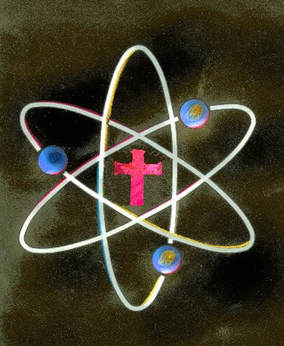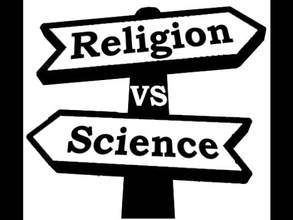
Science and Christianity are often thought to be mutually exclusive. Atheists mistakenly claim that Christians reject science because they take everything in the Bible literally and reject the the evidence from science. On the other hand, Christians argue that atheists try to fit the evidence into preexisting notions and biases and dismiss what does not fit their belief. Christians and atheists engage in mental gymnastics to fit what Christians say are miracles and atheists say are scientific mysteries. (See The Science Vs. Religion Debate - Must You Pick One Or Can They Co-Exist)
The facts are that despite many atheists’ desire to claim they have a monopoly on reason, science and Christianity are far from being mutually exclusive. Christians were responsible for many of the earliest scientific breakthroughs that form the underpinnings of modern science. Here are just a few renowned scientists who processed Christianity, and found no conflict between their work and their faith.
The following is excerpted from 6 Famous Scientists Who Were Christians by Stephanie Hertzenberg
6 Famous Scientists Who Were Christians
Galileo Galilei
Galileo Galilei is one of the most famous names in science. He is best known for his contributions to astronomy, but he also improved the science of motion and mathematics. He set up standards for length and time which allowed measurements made in different places on different days to be compared in a reproducible fashion. As an astronomer, he correctly identified supernovas as distant stars, which disproved the reigning Aristotelian belief in the immutability of the heavens, and discovered and named the largest three moons of Jupiter. His observation that Venus exhibited a set of phases, like the moon, helped tear down the geocentric model of the solar system. Galileo also observed sunspots, Neptune and was the first to realize that the “strange spots” on the moon were actually topographical features. Galileo used his artistic training to create topographical charts that estimated the height of the mountains on the moon.
Galileo’s observations often put him at odds with the Catholic Church which saw heliocentrism as heretical. Despite the church’s opinion of him, Galileo remained a devout Christian throughout his life. He saw science and religion as interrelated, stating that “God is known by nature in His works, and by doctrine in His revealed word,” and that the “Bible teaches men how to go to heaven, not how the heavens go.”
Isaac NewtonIsaac Newton is arguably the most famous name in physics and is considered to be one of the most influential scientists of all time. Born in 1643, Newton is known for laying out the foundation of classical mechanics and shared credit with Gottfried Wilhelm Leibniz for developing infinitesimal calculus.
Newton’s book “Philosophiae Naturalis Principia Mathematica” or “Mathematical Principles of Natural Philosophy” was published in 1687 and contained the laws of motion and universal gravitation that are still taught in every physics classroom today. While there have been holes discovered in his theories, it was Newtonian physics that took the Apollo missions to the moon.
Newton’s faith was nearly as odd for his time as his work. He was a devout Christian, but was unorthodox for his time. Even though he worked at the University of Cambridge, he refused to take holy orders in the Church of England. While he had set out as a scientist to explain the universe, he warned against using science to view the universe as a lifeless machine. “Gravity explains the motions of the planets,” Newton said, “but it cannot explain who set the planets in motion. God governs all things and knows all that is or can be done.”

Gregor Mendel
Gregor Mendel is often called the father of modern genetics. He carried out a series of studies on the common edible pea in 1856 and focused on seven traits that seemed to be inherited independently of other traits. He controlled the pollination of some 28,000 plants during the course of his experiments. His findings led him to state the Law of Segregation, the Law of Independent Assortment and the Law of Dominance which are known today as Mendel’s Laws of Inheritance. These basic laws form the foundation on which the modern study of genetics is built.
Genetic work has become a bone of contention with religion in recent years, but Mendel had no problem mixing science and religion. He was an Augustinian friar and abbot of St. Thomas’ Abby in Brno, Margraviate of Moravia. Mendel’s famous pea plant experiments were approved by Abbot C.F. Napp, a fellow monk, and Mendel was allowed to conduct his research on two hectares of the monastery’s gardens.
Louis Pasteur
Louis Pasteur is sometimes called the “father of microbiology.” He, along with Ferdinand Cohn and Robert Koch, is one of the three main founders of bacteriology, the study of bacteria. Pasteur is known for his breakthroughs in disease prevention which allowed for a reduced mortality from puerperal fever. He also created the first vaccines for rabies and anthrax, and his discoveries provided direct support for the germ theory of disease which revolutionized clinical medicine. Pasteur is best known, however, for disproving the long-held doctrine of spontaneous generation. His famous experiments showed that microorganisms could not develop from nothing. Instead, they were born of contamination. These experiments used a process for stopping the contamination of milk and wine that was revolutionary in its time and a form of which is still used today. The process was called pasteurization in honor of its discoverer.
Pasteur was a Catholic throughout his life. His son-in-law wrote of Pasteur: “Absolute faith in God and in Eternity, and a conviction that the power for good given to us in this world will be continued beyond it, were feelings which pervaded his whole life; the virtues of the gospel had ever been present to him.”
George Washington Carver
George Washington Carver developed techniques to return nutrients to soils that were depleted by repeated crops of cotton. He urged farmers to practice crop rotation and alternate cotton crops with sweet potatoes or legumes such as peanuts. The latter crops would restore nitrogen to the soil and give farmers both an alternative cash crop and better cotton yields in cotton years.
Carver is best known for his work on peanut crops and devised over 30 products that could be created using peanuts. Among them were dyes, plastics, milks, cosmetics, medicinal oils, soap, ink and gasoline. He also discovered 118 uses for sweet potatoes including postage stamp glue, vinegar, flour and synthetic rubber.
Carver saw no problem with being a Christian and a scientist. In fact, Carver testified repeatedly that his Christian faith was the only mechanism by which he could effectively pursue science. He believed that God provided everything that people needed, but it was up to humans to discover the secrets and uses hidden within each plant, animal or mineral.
Carl Linnaeus
Carl Linnaeus, also known as Carl von Linne or Carolus a Linne, is often called the father of modern taxonomy. He formalized the modern system of naming organism through binomial nomenclature. This system involves a generic name, now called the genus, and a specific name unique to that organism, now called the species name. Higher taxa were constructed and ordered in a simple and understandable manner. This new naming system turned sentence long, unwieldy scientific names used at the time into succinct, practical identifiers.
Linnaeus shocked the world when he classified humans just as he did every other creature. This was arguably the beginning of the debate about man’s origins that would explode with the publication of Darwin’s “On the Origin of Species.” Despite the controversy, Linnaeus stuck by his decision to classify man as part of nature rather than a distant, separate ruler of it. He never saw this as a betrayal of his Christian faith which was central to his studies. He believed that “The study of nature would reveal the Divine Order of God’s creation, and it was the naturalist’s task to construct a ‘natural classification’ that would reveal this Order in the universe.”
The so called conflict between science and religion is a modern invention and illusion. Thousands of scientists throughout history have continued to study the natural world while still holding to deep religious convictions. Devout Christians have been some of the most famous and influential scientists of all time. From Saint Hildegard who founded scientific natural history in Germany in the 12th century to Antony Hewish who won the Nobel Prize for Physics in 1974, Christians have a long history of scientific exploration and discovery, and no fictional conflict is going to keep them from continuing to learn about the world God created.
The belief that rational thought and religion don’t belong in the same room is one of the great errors of our time, and is a misconception that’s probably holding you back in more ways than one.
Consider this. God created all the universe, placed the stars and planets in their orbits, and laid down the physical laws which make it all go round. These laws of nature are constant, observable, and usable by us humans.
God make things this way for a purpose.
Remember Genesis 1:28? It features God telling the first humans to “fill the earth, and subdue it; and rule over the fish of the sea and over the birds of the sky and over every living thing that moves on the earth.”
God invites us to not only be on the earth, but to “subdue” and “rule” it. And you can’t subdue and rule what you don’t know.
That’s where science comes in. The goal of the scientist isn’t to disprove God, but to reveal natural truth—to reveal the way our universe works so that we can explore it and take advantage of its properties.
Because all truth belongs to God, the findings of science are not a threat to Christianity, but an ally—science simply reveals more and more of God’s creation.
You don’t have to leave the exciting world of science behind just because you choose to believe in God.

 RSS Feed
RSS Feed